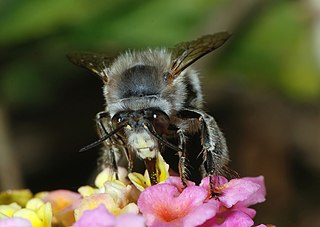
The bee genus Anthophora is one of the largest in the family Apidae, with over 450 species worldwide in 14 different subgenera. They are most abundant and diverse in the Holarctic and African biogeographic regions. All species are solitary, though many nest in large aggregations. Nearly all species make nests in the soil, either in banks or in flat ground; the larvae develop in cells with waterproof linings and do not spin cocoons. Males commonly have pale white or yellow facial markings, and/or peculiarly modified leg armature and hairs. Anthophora individuals can be distinguished from the very similar genus Amegilla by the possession of an arolium between the tarsal claws.

The hairy-footed flower bee is a species of bee belonging to the family Apidae.

Bombus crotchii, commonly called Crotch's bumble bee, is a species of bumblebee named after the entomologist George Robert Crotch. It is classified as endangered due to the impacts of pesticides, climate change, and human development.
Anthophora fedorica is a species of anthophorine bee in the family Apidae. It is found in North America.

Anthophora ursina is a species of anthophorine bee in the family Apidae. It is found in North America.
Anthophora pacifica is a species of anthophorine bee in the family Apidae. It is found in North America.

Anthophora villosula, the Asian Shaggy Digger Bee, is a species of anthophorine bee in the family Apidae. It is presumably native to Asia but has been introduced in Maryland, where it has become established.
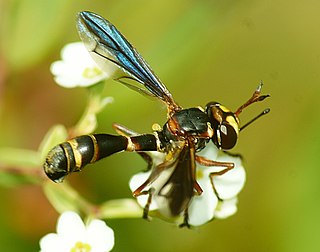
Physocephala marginata is a species of thick-headed fly in the family Conopidae. It is a parasite of Anthophora abrupta bees, although pupation occurs only after death of the host bee.
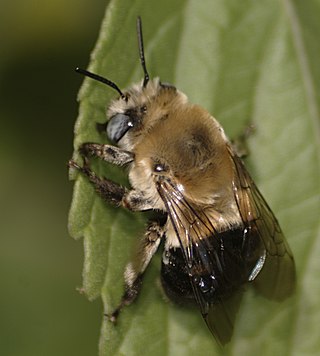
Anthophora montana is a species of anthophorine bee in the family Apidae. It is found in Central America and North America.

Anthophora californica is a species of anthophorine bee in the family Apidae. It is found in Central America and North America.

Bombus sonorus, commonly known as the Sonoran bumble bee, is a species of bumble bee in the family Apidae. It is found in Central America and western and southwestern North America. Considered uncommon, it is sometimes categorized as a subspecies of Bombus pensylvanicus.
Nomada crotchii is a species of nomad bee in the family Apidae. It is found in North America.
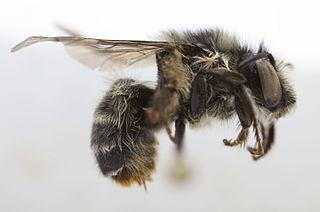
Anthophora terminalis is a species of anthophorine bee in the family Apidae. It is found in North America.
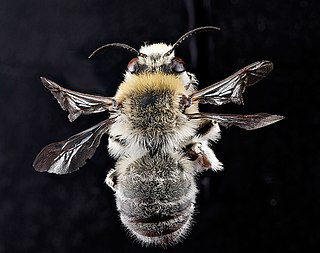
Anthophora occidentalis is a species of anthophorine bee in the family Apidae. It is found in North America.
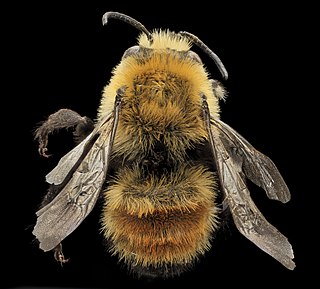
Anthophora bomboides is a species of anthophorine bee in the family Apidae. It is found in North America.
Anthophora centriformis is a species of anthophorine bee in the family Apidae. It is found in Central America and North America.
Anarta crotchii is a species of cutworm or dart moth in the family of Noctuidae.
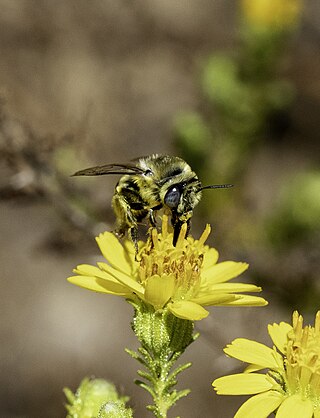
Anthophora urbana is a species of anthophorine bee in the family Apidae. It is found in Central America and North America.
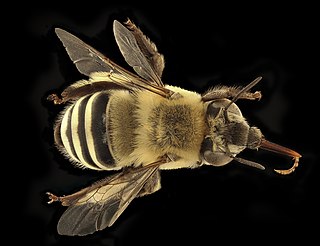
Anthophora walshii is a species of anthophorine bee in the family Apidae. It is found in North America.

Anthophora abrupta is a species of anthophorine bee in the family Apidae. It is found in North America. Females only mate once, while males can mate multiple times. This bee nests gregariously - when one female starts building a nest, others are attracted by her movements and pheromones.















